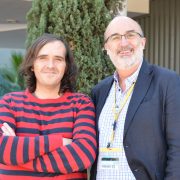Innovative methods for gene therapy in Ataxia-Telangiectasia

Research Project information
Principal researcher: Professor Ignacio Molina & Dr García-Pérez
Institute: University of Granada, Spain
Cost: £100,000 (funded in partnership with AEFAT, Spain)
Completion date: March 2024
Project Overview
Gene therapy is a technique for correcting genetic defect by inserting a healthy copy of a gene into cells (replacing a faulty gene). To deliver a gene into cells, scientists use delivery systems called vectors.
In a previous study, Professor Molina’s team demonstrated that this technique could cure A-T cells. However, the extremely large size of the ATM gene (the gene missing or not functioning completely in A-T) means most delivery systems are inefficient. To overcome this, the team studied whether a new type of vector called transposons would be suitable. Transposons can carry large genes and deliver them into target cells, and thus the team wanted to see if this approach could introduce a healthy ATM gene into A-T patient cells.
Research Methods and Outcome
The researchers introduced the full-length ATM gene into patient cells and found that whereas transposons could be introduced into deficient cells, the efficiency was not higher than that previously obtained by other viral methods and unfortunately considered insufficient to start clinical trials. Since the transfection efficiency was greatly affected by the size of the transgene, they then designed a mini-ATM gene that was about half the size of the full-length ATM gene. Transfection efficiency obtained with the mini gene was greatly enhanced and they detected a presence of the truncated mini protein. This was a relevant achievement since they considered that such construction could result in an unstable protein. They then analysed if the cellular defects typical of A-T had been rescued in mini-ATM transfected patient cells. After a detailed analysis they concluded that the truncated ATM protein was unable to revert the defects related to A-T.
What next?
Although the researchers were not successful with their gene therapy strategy, the findings are still important. It is now known that this approach to gene therapy has been tested and found at present to be ineffective. Within this fast moving and rapidly expanding field of gene therapy testing of any potential hypotheses are important.




